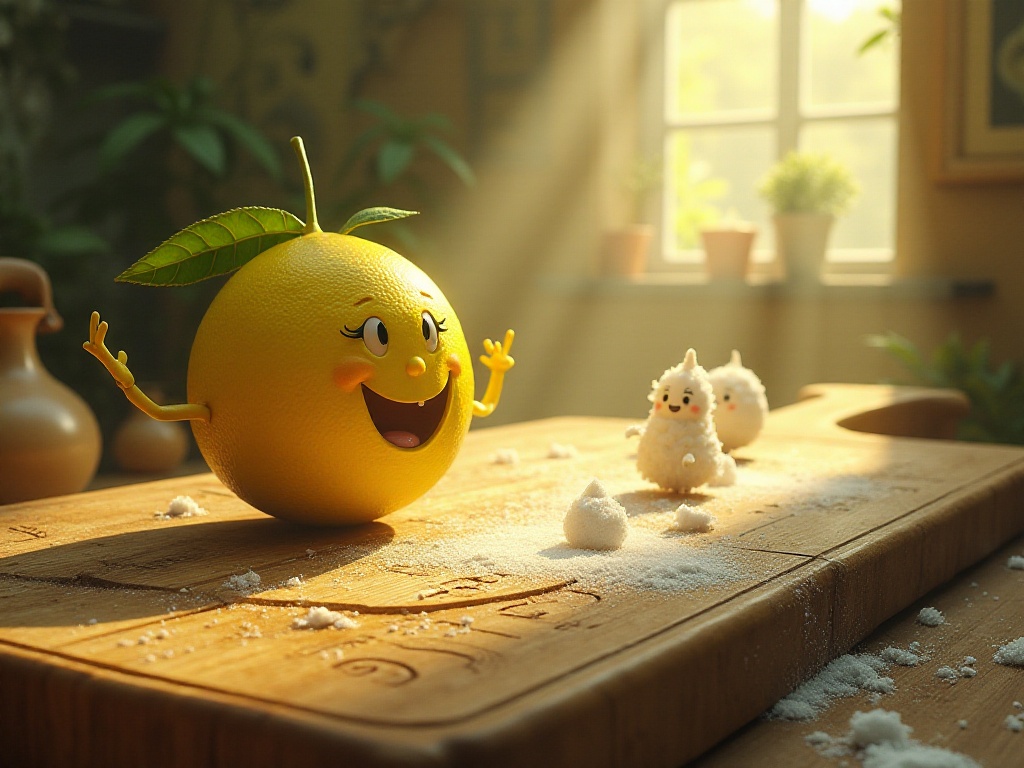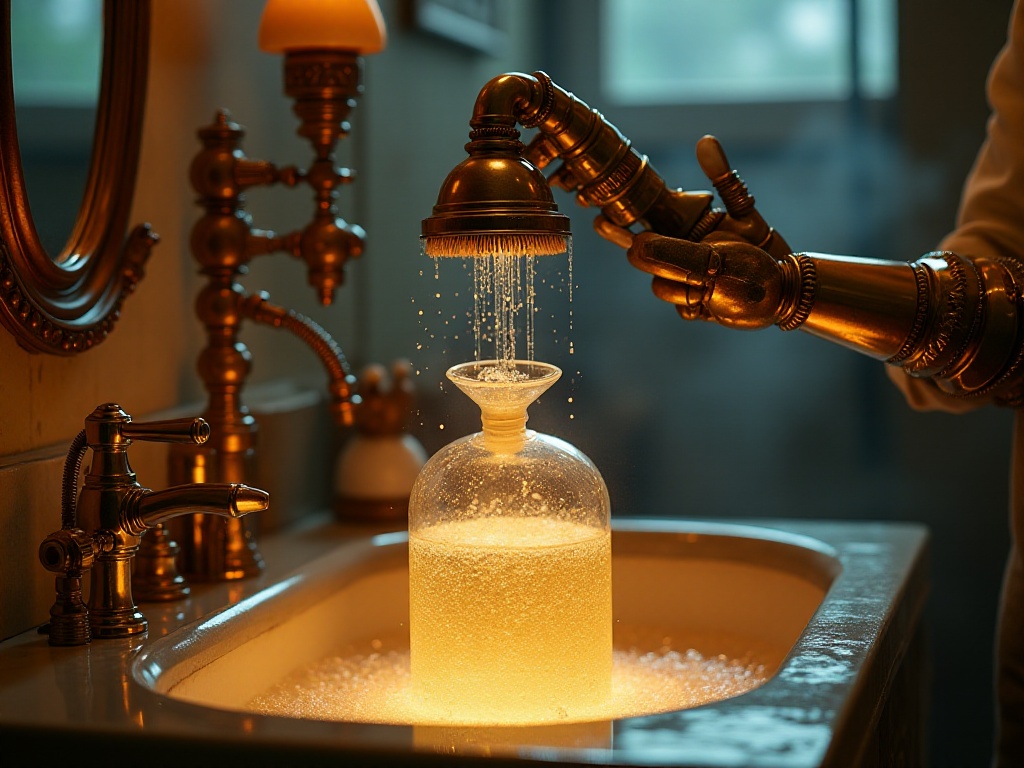Opening Thoughts
Recently while organizing my cleaning supplies, I was shocked to discover that my storage cabinet had turned into a mini chemical warehouse! All sorts of cleaners were piled up: kitchen cleaners, bathroom cleaners, glass cleaners, floor cleaners... I counted over twenty bottles, which is absolutely ridiculous!
Looking back, whenever I saw new types of cleaners on sale, I would buy them to try out. The result? Used once or twice and then forgotten in a corner. Not only did they take up space, but they were also a waste of money. Later, through continuous exploration and experimentation, I discovered that many cleaning problems could be solved using natural materials readily available at home, with results even better than those chemical cleaners!
The Power of Vinegar
To be honest, I always thought white vinegar was just for cooking. Until one time, I was struggling with stubborn limescale on my faucets. I tried commercial cleaners claiming to be "heavy-duty descalers," but they either had an overpowering smell or mediocre results. When I was at my wit's end, I saw someone online recommending white vinegar, so I bought a large bottle from the supermarket with a "why not try" attitude.
That experience really opened my eyes! I soaked paper towels in white vinegar and wrapped them around the faucet. After just half an hour, I saw the limescale starting to soften. With a light wipe, the long-accumulated limescale came off, revealing the shiny metal surface underneath. Most amazingly, these stubborn deposits didn't leave any scratches! Since then, I've fallen in love with cleaning with white vinegar.
Through repeated experiments, I found that 5% concentration white vinegar works best. This concentration effectively dissolves limescale without corroding metal surfaces. Plus, a large bottle of white vinegar only costs a few dollars, much cheaper than professional descaling products. Now I've made it a habit to deep clean my faucets and shower heads with white vinegar once a month. Over time, limescale is no longer a concern.
Beyond descaling, white vinegar has many uses. For instance, using it to clean coffee makers not only removes internal scale but also eliminates coffee residue odors. I now clean my coffee maker with white vinegar monthly, and the coffee tastes much purer than before.

The Magic of Lemons
When it comes to lemons, most people's first thought might be drinking lemon water or cooking. Actually, lemon is a cleaning powerhouse! The citric acid it contains not only kills germs and disinfects but also effectively removes odors. Most importantly, lemon's fresh fragrance is particularly invigorating and pleasant, completely different from the harsh smell of chemical cleaners.
I most frequently use lemons to clean kitchen utensils. Especially cutting boards, which inevitably develop odors over time. I used to repeatedly wash them with dish soap but could never completely eliminate the smell. Later, I discovered a brilliant method: cut a lemon in half, sprinkle some coarse salt, and rub it directly on the cutting board. The natural cleaning power of citric acid combined with the abrasive action of salt not only removes odors but also helps fade knife marks.
My proudest lemon cleaning trick is using it to clean the microwave. You know how stubborn those microwave grease stains can be, right? I used to scrub hard and worry about scratching the interior. Now I have an effortless and efficient method: find a large bowl, add two cups of water, put in four fresh lemon slices, then microwave for 5 minutes.
This process generates lots of steam, which softens stubborn grease, while the lemon's natural cleaning components break down odors. After it cools down, just wipe with a cloth, and the grease melts away like snow. Best of all, the entire process uses no chemical cleaners, making it both eco-friendly and safe. Plus, after cleaning, the microwave retains a subtle lemon fragrance, which is particularly pleasant.
Besides these, lemon slices can also remove tea and coffee stains from wooden furniture. Just gently rub the lemon directly on the stain, wait a few minutes, then wipe with a damp cloth. I maintain my solid wood dining table this way, and it still looks new.

The Wonder of Baking Soda
Speaking of baking soda, it's truly my cleaning treasure box! This white powder can be called the jack-of-all-trades in cleaning. It not only cleans but also deodorizes, softens water, and even unclogs drains. What delights me most is its price - just a few dollars for a large box, yet it can solve 80% of household cleaning problems.
Recently, I cleaned my oven with baking soda, and the results left me speechless. You know, ovens are one of cleaning's biggest challenges, with accumulated grease and burnt residue that regular cleaners can't handle. I'd previously bought specialized oven cleaners that were not only expensive but also had an extremely harsh smell, and I worried about residue affecting food safety.
Later, I developed a perfect formula: mix 3 tablespoons of baking soda with enough warm water to form a paste, then evenly spread it on the oven's interior walls. This step must be done carefully, ensuring every corner is covered. Then close the oven door and let it sit for 4 hours, allowing the baking soda to work its magic. Finally, wipe with a damp cloth, and those stubborn burnt spots come off like magic.
I also discovered baking soda is perfect for cleaning toilets. Every week, I sprinkle some baking soda in the toilet, let it sit for 15 minutes before flushing, and it not only removes scale but also eliminates odors. Best of all, this method is particularly environmentally friendly and won't pollute the drainage system.
Baking soda can also make carpets look like new. My beige carpet started yellowing after two years, looking particularly dirty. I tried professional carpet cleaners with disappointing results. Later, I evenly sprinkled a layer of baking soda on the carpet, waited several hours, then vacuumed it up, and the carpet returned to its original color! It turns out baking soda not only absorbs stains but also removes odors from carpets.
Creative Tools
After discussing natural cleaners, I want to share some creative cleaning tools I've discovered. Sometimes, a simple change in how you use a tool can increase cleaning efficiency several times over.
My most exciting discovery was using rubber gloves to clean pet hair. Since getting a cat, there's been cat hair everywhere, especially on fabric sofas and carpets, which even vacuums can't clean thoroughly. I tried various hair removal tools with mediocre results. Until one day, I accidentally discovered that when I touched the sofa wearing rubber gloves, the cat hair automatically stuck to the gloves!
After multiple experiments, I developed the best method: wear rubber gloves, slightly dampen them, then gently wipe over the surface needing cleaning. The static electricity generated by the rubber material automatically attracts the hair to the gloves. This method is at least three times more efficient than traditional lint rollers and requires much less effort.
Old toothbrushes are also amazing tools. I specifically keep several old toothbrushes for cleaning. They're particularly suitable for cleaning small crevices, like window tracks and faucet bases. I also use toothbrushes to clean keyboards - slightly dampen the brush with alcohol, gently brush through the keyboard gaps, and even the most stubborn dust can be cleaned thoroughly.
Microfiber cloths are also my favorite. Although they're more expensive than regular cloths, their cleaning effectiveness and durability far exceed ordinary cloths. I particularly like using them to clean glass - no cleaning agent needed, just water can make it spotless, without leaving any lint or water marks.
Cleaning Order
Speaking of cleaning order, this is truly a technical skill! Many people have learned this the hard way, myself included. I remember when I first started cleaning by myself, I would often mop the floor first only to remember I needed to clean the ceiling fan, resulting in dust falling down and having to mop again, wasting lots of time and energy.
After countless practices and summaries, I finally developed a scientific cleaning order: top to bottom, inside to out, clean to dirty. This order seems simple, but it requires quite a few techniques to execute properly.
For example, when cleaning ceiling fans, I now use a pillowcase to cover the blade while cleaning. This not only prevents dust from flying everywhere but also cleans thoroughly in one go. After cleaning, just throw the pillowcase in the washing machine - very convenient.
When cleaning the bathroom, I handle the toilet and bathtub, the dirtier areas, first, then clean the sink and mirror. This prevents cross-contamination of cleaning tools. I also prepare two cloths, one specifically for the sink and mirror, another for the toilet and floor.
Window cleaning also has its tricks. I always clean the window frames and tracks first, then the glass. This prevents frame dust from falling onto freshly cleaned glass. Also, window cleaning should be done on cloudy days or during early morning/evening hours - strong sunlight makes cleaning agents dry too quickly, easily leaving water marks.
DIY Cleaners
Honestly, since learning to make my own cleaners, I've lost all interest in buying those expensive commercial cleaning products. Not just because it saves money, but more importantly, these homemade cleaners are particularly eco-friendly and safe, giving me peace of mind when using them.
My most frequently used recipe is: 1 part white vinegar, 1 part baking soda, 2 parts warm water. This recipe is truly a cleaning cure-all, suitable for cleaning bathroom tiles, kitchen counters, sinks, and many other areas. Plus, all ingredients are readily available at home, so you can mix it anytime.
Using this homemade cleaner for a year, I calculated savings of at least $50 in cleaning supplies. Most importantly, its cleaning effectiveness is no worse than chemical cleaners. Especially when cleaning bathroom tiles, it not only removes scale but also prevents mold growth.
Besides this basic recipe, I've developed some targeted formulas. For example, a special glass cleaning formula: 2 parts water, 1 part white vinegar, add a few drops of dish soap. This formula can make glass particularly bright and clear, without leaving any water marks.
To remove carpet stains, I use: 1 part white vinegar, 1 part warm water, appropriate amount of baking soda. First spray this solution on the stain, wait a few minutes then wipe with a clean towel - even stubborn coffee stains can be easily removed.
Reflections and Insights
Through these years of exploration and practice, I deeply understand: the best cleaning solutions are often the simplest. Many expensive cleaning products can be replaced with common natural materials found at home, and the results might even be better.
Thinking about our ancestors, they had mastered this wisdom in an era without modern cleaning products. Using vinegar for descaling, lemon for deodorizing, baking soda for cleaning - these methods have been passed down for thousands of years and still work today. We've just been blinded by modern commercial marketing, always thinking expensive means better.
Actually, housework isn't boring if you use the right methods. Like now, every time I clean, I feel particularly accomplished. Seeing the house renewed, smelling the fresh natural scent, my mood becomes particularly pleasant.

Practical Advice
If you want to try these natural cleaning methods, I suggest starting with the simplest - vinegar for descaling. Once familiar with this method, gradually try other recipes. After all, every household is different, and you need to find what works best for you through practice.
When using these natural cleaners, pay attention to some details. For example, directly mixing vinegar and baking soda will cause a violent chemical reaction, so be especially careful. Don't use vinegar on marble countertops, as acidic substances will corrode marble.
I now spend time every week researching new cleaning methods, feeling like a cleaning laboratory researcher. I get particularly excited whenever I discover new cleaning tricks. Recently, I've been researching how to use these natural materials to make skincare products, and I'll share when I succeed.
Cleaning is both a science and an art. Creating a clean and tidy home isn't difficult once you master the right methods. I hope these experiences I've shared can help you. If you have any unique cleaning tricks, please let me know, and let's make our homes more beautiful together.


